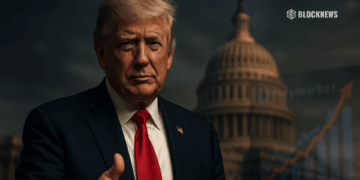- Robinhood CEO Vlad Tenev says crypto is shifting from a speculative asset to core financial infrastructure, with tokenization as a “freight train” set to reshape markets over the next 5–10 years.
- Robinhood is backing that thesis with action: growing crypto revenue, acquiring Bitstamp, rolling out tokenized stocks on Arbitrum, and building its own Ethereum L2 to host tokenized assets.
- Regulation remains the main bottleneck, especially in the U.S., but each move by major platforms to treat crypto as infrastructure makes it harder for policymakers to dismiss it as a passing bubble.
Robinhood CEO Vlad Tenev isn’t talking about crypto like a side quest anymore. He’s talking about it like core infrastructure. In recent TV hits and conference appearances, he’s been pretty direct:
Crypto technology, in his view, is going to power the entire financial system and tokenization is a “freight train” heading straight for global markets over the next 5–10 years.
Coming from a trading app that used to be all about stocks and options, that’s already a big shift. Coming from a company that now gets a huge share of transaction revenue from crypto, is building its own blockchain stack, and is buying a major global exchange, it lands differently. It sounds less like hype and more like a strategy memo he’s just reading out loud.
Tenev’s main point is that most people still stare at the coins — BTC, ETH, SOL — but miss the rails. He’s arguing that the real unlock is the underlying infrastructure: blockchains that can move any asset, any time, with settlement built into the protocol. In other words, crypto isn’t just a casino; it’s an upgrade to things like SWIFT, DTCC, and the brokerage backend you never see.

Robinhood Is Quietly Rebuilding Around Crypto Rails
This “crypto as infrastructure” talk would be easy to ignore if Robinhood wasn’t backing it with product. But it is, aggressively.
In Q1 2025, Robinhood’s crypto trading revenue doubled year-over-year to roughly $252 million, making up more than 43% of total transaction revenue. That’s not hobby money. That’s core business. At the same time, they’re pushing deeper into the space with the planned acquisition of Bitstamp, giving them licenses, infrastructure, and institutional access across more than 50 countries.
On the product side, Robinhood has already rolled out tokenized U.S. stocks and ETFs for EU users on Arbitrum, with more than 200 assets trading 24/7. The long-term plan is to migrate that activity onto their own Ethereum Layer 2, built on the Arbitrum stack, specifically tuned for tokenized equities, funds, and eventually things like real estate and private company shares.
Put all that together and the picture is pretty clear: they’re not just putting crypto inside a brokerage app. They’re trying to put the brokerage itself on crypto rails. One interface where you can move between stocks, stablecoins, tokenized funds, and other assets without really thinking about which chain you’re touching behind the scenes.
Why This Is Bullish for Crypto Beyond Just HOOD
When a regulated, U.S.-listed broker leans in this hard, it shifts the narrative for the entire sector.
First, it reinforces the idea of “crypto as neutral infrastructure” — a framing BlackRock, Fidelity, and others have been inching toward with ETFs and tokenization pilots. Tenev isn’t out there saying “buy this altcoin, number go up.” He’s saying: this is the tech stack future capital markets will run on. That’s a tone regulators and policymakers are a lot more comfortable with than meme-token hype.
Second, it pushes the conversation firmly toward 24/7 global markets. Tenev has repeatedly said that once people get used to trading tokenized assets around the clock, across borders, old-school market hours are going to look ridiculous. Crypto-native traders already live in that world. If platforms like Robinhood fully bridge their user base into it, on-chain liquidity can scale a lot faster than most people are modeling.
Third, it yanks crypto into much bigger total addressable markets. Tokenization plus brokerage integration means we’re not just talking about “the crypto pie” anymore. You’re talking equities, bonds, real estate, private markets — tens of trillions in assets. When CEOs start treating that shift as inevitable, you typically see more builders, more capital, and faster regulatory attention follow.

The Regulatory Drag Still Matters
None of this is automatic. Tenev has been pretty blunt that regulation in the U.S. is still behind the technology, especially when it comes to tokenized securities. The tech can already handle 24/7 tokenized stocks; the law and licensing frameworks are what’s dragging.
That’s why some of the more aggressive Robinhood moves — like tokenized stocks — are launching in Europe first, where rules under MiCA and other regimes are clearer. U.S. users will likely see the full “trade anything, anytime” version later, not earlier.
Still, the direction of travel doesn’t change. Each time a major consumer platform talks about crypto as plumbing rather than a punt, it gets harder for regulators and incumbents to treat it like a fad. They can slow it down, complicate it, carve out weird exceptions — but ignoring it gets more expensive.
From Casino Narrative to Core Market Infrastructure
Zoomed out, Tenev’s recent comments are doing three things at once. He’s obviously talking his own book, because Robinhood’s growth is increasingly tied to crypto revenue and tokenization. He’s also signaling to Wall Street that tokenized markets — not just spot crypto trading — are going to be a serious line of business. And he’s normalizing crypto rails as an upgrade to the current system instead of a total revolution, which is exactly how large institutions prefer to adopt new tech.
For individual investors and crypto natives, the takeaway is pretty straightforward: if players like Robinhood, BlackRock, and others are all building on similar rails, the question isn’t really if crypto infrastructure goes mainstream. It’s how fast it gets there and who captures the upside.
We’re still early, regulation is still messy, and not every token will benefit equally. But when a CEO whose business depends on retail, compliance, and public markets says, “this tech is going to power the entire financial system,” that’s not just engagement bait. It’s a pretty clear hint about where a big chunk of fintech — and maybe finance in general — is heading.














